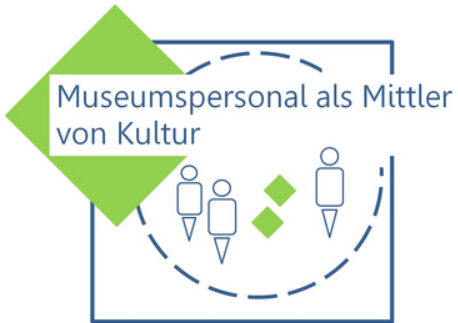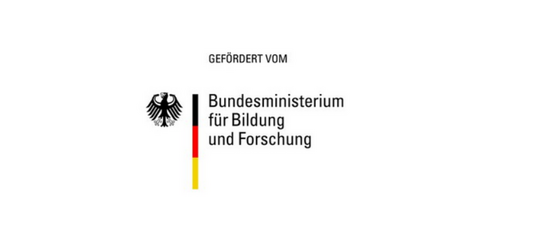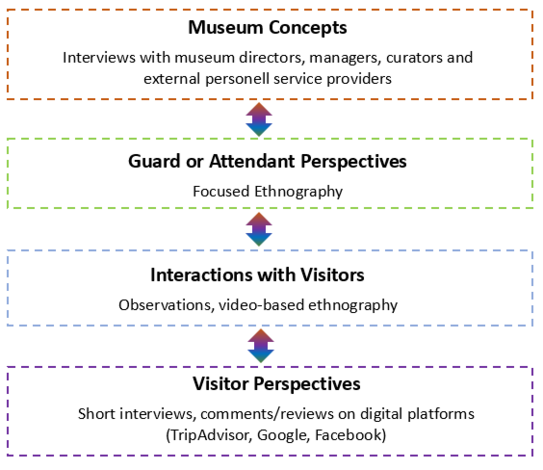Guards - Mediators - Animators
On the Role of Museum Attendants in Cultural Education at the Museum
The relationship between cultural offerings and modes of reception is necessarily a mediated one. If one also assumes that mediation in the museum takes place primarily in concrete interaction situations, i.e. in the exhibition itself, then one position in museums comes into view which has to be considered as nearly neglected by research: The museum gurads and attendants.
The project focused on this position in the museum. The project interrelates museum concepts and the perspective of museum authorities, interactions between guards and visitors as well as visitor perspectives.

The following questions were in focus:
Against the background of which museum and staff concept do museum gurads fulfill disciplining abd/or service tasks as well as animation functions, and in what form?
How does the service staff interact with the museum visitors, and on which constellations of conditions in the very situation are these interactions depending?
Selected insights
With regard to museum and staff concepts, a wide range of different positions occurs. Although the museum genre reveals certain tendencies in this respect, the concepts also differ within the genres. Nevertheless, two central contexts can be identified: First, the role of power relations in terms of the lines drawn to determine who is an acceptable subject of mediation in museums and who is not. Second, there are strong connections between the museum or staff concept, the inherent visitor concept and the opportunities for getting in touch with the visitors. Furthermore, these opportunities define the opportunities for appreciation by the museum authorities as well as the visitors. In general, the opportunities for appreciation are narrowly defined.
- The hinge function of the personnel oscillates between safety-related and service-related activities, whereby the spectrum of the field of activity is diverse and ambivalent (e.g., enforcing rules vs. creating a 'pleasant' atmosphere).
- The interaction study has shown that this conflict is mitigated in practice and in some cases even eliminated. The tension between safety-related and service-related activities does not appear as a contradiction in the interaction, but rather safety-related disciplining can be the cause for interaction.
- The visitor and staff concepts of the museums do not allow any direct conclusions to be drawn about the concrete practices of the museum gurads: they even fulfill a mediation function if the museum authorities do explicitly not intend this.
- Status and satisfaction with the professional position: The 'low status' in the museum organization is present in the field and is carried and actualized by narratives of top/down.
- Dependence on the concrete (also spatial) exhibition situation: The specific configuration of the relation of subject - object - space - time is constitutive for interactions.
- Social recognition of lifestyles and cultural preferences: A central condition for the concrete configuration of an interaction situation is the categorical classification and allocation of the visitors by the museum guards.
- Pluralization: Social identifiers have lost their uniqueness. Categorizations, which are made practically relevant by the guards are hardly explicable, but nevertheless effective.
- Visitor perspectives after using hands-on exhibits: Different knowledge stocks can be systematized: a) safety-relevant knowledge, b) anecdotal knowledge, c) contextual information about exhibits, d) technical knowledge, and e) everyday knowledge. Individualization tendencies and postmodern subject understandings clearly emerge here. The staff is rated positively, in particular, when it responds to the individual needs of the visitors. Cultural education in museums is related to semantics of self-regulation, self-responsibility and self-disciplining, which - depending on the genre - are partly embedded in play-oriented apparatuses.
Further insights
Publications
- Eickelmann, Jennifer; Burzan, Nicole (2023): Challenges of multimethod and mixed methods designs in museum research [36 paragraphs]. In: Forum Qualitative Sozialforschung / Forum: Qualitative Social Research, 24(1), Art. 12, http://dx.doi.org/10.17169/fqs-24.1.3988 , Special Issue “Mixed Methods and Multimethod Social Research – Current Applications and Future Directions”.
- Burzan, Nicole; Eickelmann, Jennifer (2022): Machtverhältnisse und Interaktionen im Museum. Franfurt a.M./New York: Campus.
- Eickelmann, Jennifer (2021, i.E.): Considerérant le presque invisible. Gardiens de musée en tant qu’intermédiaires. In: La Documentation française (Ed.): Documenter les collections de musées. Investigation, inventaire, numérisation et diffusion.
- Eickelmann, Jennifer; Burzan, Nicole (i.V.): Das Museum im Spannungsfeld von musealer Deutungsmacht und Publikumsorientierung. Zur Scharnierfunktion von Museumsaufsichten.
- Burzan, Nicole; Eickelmann, Jennifer (2020): Über die Vermittlungsfunktion des Aufsichts- und Servicepersonals bei der kulturellen Bildung im Museum. In: Timm, S.; Costa, J.; Kühn, C.; Scheunpflug, A. (Hg.): Kulturelle Bildung. Theoretische Perspektivien, methodologische Herausforderungen, empirische Befunde. Münster/New York: Waxmann, 177-194.
- Burzan, Nicole (2018b): Möglichkeiten und Grenzen des ‚Herumschnüffelns‘ in einer Organisation mit Publikumsverkehr. Hemdsärmelige und reflexive Praxis einer Untersuchung zum Servicepersonal in Museen. In: Hitzler, R.; Klemm, Matthias; Kreher, S.; Poferl, A.; Schröer, N. (Hg.): Herumschnüffeln – aufspüren – einfühlen. Ethnographie als ‚hemdsärmelige‘ und reflexive Praxis. Essen: Oldib, 135-145.
- Burzan, Nicole (2018a): „Das ist jetzt bestimmt mein achtzehntes Paar Schuhe.“ Zugehörigkeiten anzeigende Objekte von Museumspersonal an der Schnittstelle zwischen Organisation und Publikum. In: Poferl, Angelika/Pfadenhauer, Michaela (Hrsg.): Wissensrelationen. Beiträge und Debatten zum zweiten Sektionskongress der Wissenssoziologie. Weinheim/Basel: Beltz Juventa, S. 299-307.
- Eickelmann, Jennifer (2018): „Schauen Sie sich doch mal die Vasen aus China an!” Das Aufsichtspersonal im Museum als ‚kritische Zone‘ zwischen ExpertInnen und Alltagswissen. In: Poferl, Angelika; Pfadenhauer, Michaela (Hrsg.): Wissensrelationen. Beiträge und Debatten zum zweiten Sektionskongress der Wissenssoziologie. Weinheim/Basel: Beltz Juventa, S. 342-352.
- Burzan, Nicole (2017b): Menschen im Museum. Theoretische Perspektiven auf empirische Erkundungen". In: Sociologia Internationalis 55 (1), S. 1-26.
- Burzan, Nicole (2017a): Zum Wandel von Raum- und Zeitstrukturierungen am Beispiel von Museen. In: Zeitschrift für Theoretische Soziologie (ZTS), Sonderband 4: „Raum und Zeit. Soziologische Beobachtungen zur gesellschaftlichen Raumzeit“, hgg. von Anna Henkel, Henning Laux, Fabian Anicker, S. 171-187.
Oral Presentations
- Burzan, Nicole & Eickelmann, Jennifer: "Tackling Access Barriers? On the Significance of Museum Guards/Attendants regarding the Museum's Inclusion Processes in Germany". 12th International Conference on the Inclusive Museum, Muntref, Museum of Immigration, Buenos Aires, 7.-9. November 2019 [angenommen].
- Burzan, Nicole & Eickelmann, Jennifer: "Positionierungen von Museumsaufsichten. Zur Organisation und Praxis musealer Hegemonien“. Offene Jahrestagung der DGS-Sektion Kultursoziologie in Kassel, 30.September - 2. Oktober 2019.
- Eickelmann, Jennifer: "Museale Entanglements und ihre bildungspolitischen Versprechen. Ein diffraktiver Zugang", Workshop 'Leben mit Maschinen. Zum (Sinnlich-)Schöpferischen von Mensch-Maschine-Interaktionen', Kunstakademie Düsseldorf, 28. Juni 2019.
- Eickelmann, Jennifer: "Considering the Almost Invisible. Museum Guards or Attendants as Intermediators", International Symposium of the École du Louvre Research Seminar, Paris, 13. Juni 2019. Hier gehts zum École du Louvre
- Burzan, Nicole & Eickelmann, Jennifer: "Aufseher - Vermittler - Animateure. Zur Rolle des Servicepersonals bei der kulturellen Bildung im Museum". Forschungskolloquium des Instituts für Soziologie, TU Dortmund, 4. Juni 2019.
- Burzan, Nicole: "Hierarchische Polaritäten in der Organisation Museum: Formen, Deutungen, Rahmenbedingungen und Herausforderungen ihrer methodischen Erfassung", Frühjahrstagung der DGS Sektion Methoden der qualitativen Sozialforschung, TU Dresden, 27.-28. März 2019.
- Burzan, Nicole & Eickelman, Jennifer: "Herausforderungen der empirischen Untersuchung distinktiver Praxis angesichts gesellschaftlicher Pluralisierungsprozesse“, Vortrag im Rahmen der Tagung ‚40 Jahre ‚Die feinen Unterschiede‘. Zur Aktualität von Pierre Bourdieus Gesellschaftstheorie in der kultursoziologischen Ungleichheitsforschung‘, Universität für Musik und darstellende Kunst (mdw), Wien, 13.-15. März 2019.
- Eickelmann, Jennifer: „Von der Überwachung zur Assistenz. Erlebnisorientierte Sinnes-Regime und Effekte für museales Aufsichts- und Servicepersonal", Vortrag im Rahmen des Workshops 'Sehen - hören - Riechen - Schmecken - Spüren. Sensorische Aspekte der Erkundung von Wissensbeständen', TU Dortmund, 7.-8. Dezember 2018.
- Eickelman, Jennifer: "Politiken des Sicht- und Sagbaren im Museum, oder: Dürfen Museumsaufsichten Kunst vermitteln?", Vortrag im Rahmen der Tagung 'Künste und Mächte - Politiken in den Künsten und durch die Künste', AK 'Soziologie der Künste' der Sektion Kultursoziologie der DGS, 22-23. November 2018.
- Eickelmann, Jennifer: „(Un-)Professionelle Vermittlungsarbeit im Museum", Vortrag im Rahmen der Sektionsveranstaltung 'Zeitgenössische Bedrohungen professioneller Expertise – und ihre Verteidigung' der Sektion „Professionssoziologie“ auf dem 39. Kongress der Deutschen Gesellschaft für Soziologie in Göttingen, September 2018.
- Burzan, Nicole: „Reflexivität als Gütekriterium empirischer Forschung am Beispiel ethnographischer Erkundungen von Museumspersonal“, Vortrag bei der Frühjahrstagung der DGS-Sektion „Methoden der qualitativen Sozialforschung“ in München, März 2018.
- Burzan, Nicole: „Zugehörigkeiten anzeigende Objekte von Museumspersonal an der Schnittstelle zwischen Organisation und Publikum“; Vortrag im Rahmen des Sektionskongress Wissenssoziologie an der TU Dortmund, September 2017.
- Eickelmann, Jennifer: „Schauen Sie sich doch mal die Vasen aus China an!“ Das Aufsichtspersonal im Museum als ‚kritische Zone‘ zwischen Experten- und Alltagswissen. Vortrag im Rahmen des Sektionskongresses Wissenssoziologie, Arbeitskreis Expertenwissen, Teilthema ‚Absichtsvolle Verfremdung. Zum Verhältnis von Alltags- und Expertenwissen‘, September 2017.
- Burzan, Nicole: „Möglichkeiten und Grenzen des ‚Herumschnüffelns‘ in einer Organisation mit Publikumsverkehr. Hemdsärmelige und reflexive Praxis einer Untersuchung zum Servicepersonal in Museen“; Vortrag bei den 6. Fuldaer Feldarbeitstagen, Juni 2017.
Workshops / Transfers
- „Möglichkeitsräume für das Aufsichts- und Servicepersonal im Museum: Zum Verhältnis von Interaktion – Vermittlung – Anerkennung“, DASA Dortmund, 5. Juli 2018.
- „Aufseher – Vermittler – Animateure Zur Rolle der Interaktion zwischen Servicepersonal und Besucherschaft“ im Rahmen des Szenografie-Kolloquium in der DASA, Dortmund, 25. Januar 2017.
Project duration
12/2016 to 11/2019 (36 months)
Team
Lukas Arp


![[Translate to English:] [Translate to English:]](/storages/zentraler_bilderpool/_processed_/b/9/csm_Spektralringe_225cc86301.jpg)

